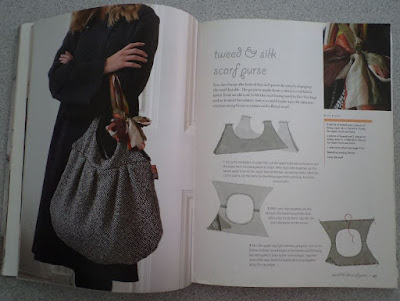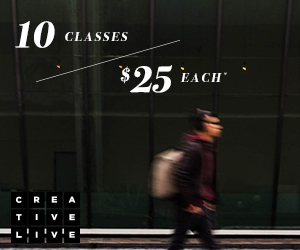 |
| Sewing resources in dead tree format... |
When I went on vacation in mid-September, I took along three books. They were the ones that I mentioned at the end of my previous
post about borrowing sewing books from the library.
Today I'll be doing some quickie reviews of them. (And understand that I cannot speak about actually making a project from any of these books, since I did not do so. I'll leave that for
next week.)
The Bag Making Bible by Lisa Lam
This comprehensive book is a one stop shop for learning all of the techniques of bag making. I don't think she's left anything out, to be honest. She even provides a fabric selection guide for what might be suitable for various styles of bags. If you can master the skills, I daresay you'll be able to design your own bag. But if that's not your thing — yet — there are 8 projects included with this volume (for which full size pattern templates are included).
 |
| Project from The Bag Making Bible by Lisa Lam... |
The projects range from a very simple unlined book bag to a party clutch to a large messenger to an "oversized fashionista bag" (that instantly caught my eye; see above photo) to a travel bag to a piped hobo (which also caught my eye). In my case, however, I did not end up motivated to make either of them, for entirely practical reasons. For those who are interested in attempting the projects, let me say that because of how the book is laid out, you will have to jump back and forth from one section to another. (You might also want to take heed of Daryl's
comment from my previous post.) Each bag's set of instructions is not totally linearly presented as a standalone tutorial/pattern PDF normally is, which may prove frustrating for some.
My main takeaway from this book are in the individual techniques. For me, the part about using darts — on a bag body as well as in the constuction of a pocket — was particularly valuable.
Sewing Stylish Handbags & Totes by Choly Knight
This book gave me a lot of great ideas. And despite the fact that none of the fabrics appealed to me, I appreciated how they enabled me to see the actual features of each bag. The result was that I actually wanted to try three or four of the book's eighteen projects (for which full-size patterns are included). However, when I actually inspected the instructions for each bag, I found myself wanting more... way more.
 |
| Project from Sewing Stylish Handbags & Totes by Choly Knight... |
For example, there is a project called the "Mod Weekender Bag" that I liked (it reminds me of a bowling ball bag with a cool looking curved zipper pocket on the front). The main zipper closure is the kind that is an extension of the bag's gusset; i.e., not a simple technique. And yet, there are only nine steps to making the bag! Even though this particular one is an intermediate level project and — like the other volumes — individual techniques are presented on their own at the front of the book, I think most readers would appreciate a smidge more assistance when it come to the actual "how to".
The author's use of stencils and appliques on basic monochrome fabric choices made for some interesting looking bags, although I occasionally found them to look more charmingly "homemade" than "handmade". Not to knock the approach, because I think stencilling has its place and I found myself wanting to try an applique on some future project.
Because of the way the instructions are written, I really cannot recommend this volume (to beginners or otherwise). But if — like me — you're looking for different ideas to make your own custom bags, you may find this inspiring.
Watch live classes for FREE at CreativeLive!

[affiliate link]
The Perfect Handmade Bag by Clare Youngs
Being a fan of reuse and repurposing, I was very interested in checking out this book, which features 35 projects made out of found fabric and recycled hardware. (The author provides excellent tips on how and where to find the best stuff for your creative efforts.) The contents are divided into five sections: for purses, shoulder bags, shoppers and totes, evening bags, and kids' bags. Unfortunately, the templates are not full-size, so you will have to get them photocopied and blown up... definitely
not a plus!
One of the things I liked about this book was how the author turns you into a "designer" by showing you how to create your own distinctive labels to attach to your original creations. Very neat!
 |
| Project from The Perfect Handmade Bag by Clare Youngs... |
The projects themselves will appeal to a wide variety of tastes. I found myself drawn to the "tweed and silk scarf purse" (see above) and may attempt one if I eventually find the right material to recycle. The instructions for all of the bags are illustrated with hand drawings and are quite thorough. Basic techniques are covered at the back of this volume, along with a simple glossary of terms.
Overall, this is another inspiring book that you can flip through to get ideas even if you aren't taken with the actual projects.
Final Assessment
I have three main beefs about the printed book format.
The primary one concerns the pattern templates. If they are actually provided in actual size, they will likely be printed double-sided on one large sheet with various overlapping pieces. That is, you will not be able to cut them out "as is." (And of course, that would be if you owned the book and did not borrow it from the library!) Believe me, it is a serious pain in the butt to trace these... I tried it and did not enjoy the process. It is
so much easier to print templates from a PDF, piece them together as required and have relatively sturdy pattern pieces from the start.
Take a look here:
 |
| Sample pattern template sheet... |
Of the two that I encountered, this one is actually better, because at least each overlapping pattern piece is in a different colour. In the other one, the pieces are only
outlined in a different colour and that was only used to differentiate between projects. There was one project with two overlapping pieces, making it a challenge to trace them properly. Recall my post about
what I dislike most about sewing? Having to trace pattern pieces is now right up there at the top of the list!
My second beef has to do with the physical constraints of a book. From a publishing perspective, there is likely the notion that "this book should not exceed
x number of pages". Therefore, the quantity of photos and instructions are going to be pared down to fit the format. With multiple projects in each volume, this restriction invariably leads to situations where even free tutorials available online are more clearly (and linearly) documented than some of the projects in these books. This means that for a beginner — while the ubiquitous introduction section is very valuable in terms of collecting all of the necessary basic techniques in one place — the instruction set for each project is likely to be wanting. So yes, just a little bit of a catch-22.
Get Betz White's Flight Bag class with your free Creativebug trial...Check out my review here...
[affiliate link]
My third beef is that it has become apparent to me that projects featured in sewing books may not be thoroughly tested or tested at all. I have now examined at least six or seven other books beyond these, researched opinions about them online, and encountered complaints about fabric allocation errors, missing or incorrect steps and other
errata that may make the experience a bit frustrating. (Causing people to waste fabric would be a big no-no!)
With all this in mind, I think it's great that I can go to the library to give sewing books a trial run. If I were seriously in the market to buy myself a book — and personally, having now "experienced" them, I doubt I ever would be — it's convenient that I can ensure that the contents appeal to me before committing my dollars.
What do you think? Do books have any great advantages over electronic PDFs?



























